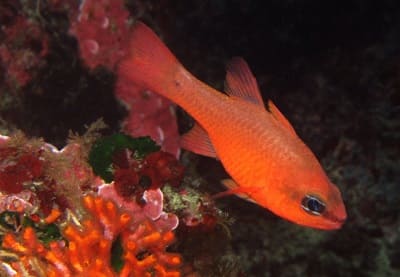Home › Sea Life › Marine › Vertebrates › Cardinal Fishes › Apogon Imberbis
Interesting Facts about Apogon Imberbis
[Phylum: Chordata] [Class: Actinopterygii] [Order: Kurtiformes] [Family: Apogonidae (ray-finned)]
Most of the two hundred species of cardinalfish have some red colouring with a laterally compressed, oblong, body and huge eyes.
This guide contains facts and information about the Mediterranean cardinalfish (also called King of the Mullets) and how they differ from other ray-finned fishes.
Cardinalfish (Apogon Imberbis) Distribution
You will find the vast majority of the Apogonidae family (cardinalfishes) inhabiting many regions of the Mediterranean Sea.
The species is also widely distributed along the coastline of the eastern Atlantic, stretching from Portugal down to the Gulf of Guinea.
Here's the thing:
Mediterranean cardinalfish are quite solitary. So, you tend to find them hiding in rocky areas and narrow crevices.
They also inhabit the partially shaded zones of shallow, marine caves.
Pro Tip: Another species of ray-finned fish, the Astrapogon stellatus (conchfish) are commonly found in the Gulf of Mexico, the Caribbean Sea, and the tropical western Atlantic Ocean.
Mediterranean Cardinalfish Characteristics
It is easy to spot the ovate (egg-shaped) "cardinal red" body of the Apogon imberbis. The large head is noticeably larger than the short, upturned snout.
A protruding lower jaw, shorter than sling-jaw wrasses, contains rows of tiny villiform teeth. The long pectoral fin stretches down to the start of the anal fin. You should also see signs of emargination in the caudal fin.
These ray-finned fishes have large ctenoid scales. It is also common for most cardinalfishes to have two or three dark spots running along the base of the caudal fin.
In case you were wondering:
Mediterranean cardinalfish are small, usually no bigger than ten (10) centimetres in length. Even so, the maximum recorded size for 'King of the Mullets' is fifteen (15) centimetres (6 inches).
What Does Apogon Imberbis Eat?
Having big eyes means this species is content with spending a lot of the daytime hours in dark ravines. It becomes a lot more active in deep water at night to hunt for food.
 When the water temperature warms, they tend to stay in a depth range of ten (10) to seventy (70) metres.
When the water temperature warms, they tend to stay in a depth range of ten (10) to seventy (70) metres.
But, they will dive deeper to escape the coldness during the winter months - down to two hundred (200) metres.
The Mediterranean cardinalfish is carnivorous, feeding on:
- Aquatic crustaceans (e.g. Artemia, brine shrimp)
- Euphausiacea (krill)
- Marine invertebrates
- Opossum shrimps
- Tiny organisms (e.g. zooplankton)
Many of the Mediterranean dive sites offer ideal opportunities to catch sightings of this species as they search for food scraps, especially around artificial reef structures.
Apogon Imberbis Reproductive Process
In fact, oviparous reproduction in fishes is commonplace, and parental care is mostly praiseworthy for cardinal fish families. Even so, the males have been known to eat the eggs, often by accident during the courtship ritual.
In general, the optimum time for Mediterranean cardinalfish to lay eggs is the hot summer months of June through to September.
Internal fertilisation takes place through 'palpitating' movements. This tends to be a weak nuptial dance performed between the fins of the mating partners.
Typically, at least three (3) females will accompany one male in advance of the spawning event. The outcome can turn out to be batches of up to 20,000 eggs.
Threats and Predators
In fact, the threat status for the Mediterranean cardinalfish species in Europe is of 'Least Concern' according to the information on the IUCN website.
But, even though they are not endangered, fishers sometimes use the Apogon imberbis as bait. Plus, they are also consumed by humans and traded by aquarists for the pet aquarium industry.
Fun Facts about Apogon Imberbis
- The male cardinalfish has the responsibility of keeping the eggs inside its mouth until they hatch. So, until the male expels the eggs, usually eight (8) days later, it does not eat any food.
- Incubating eggs inside the mouth has the advantage of protecting them against natural predators, such as the horn shark (Heterodontus francisci), during the initial phase of their development.
- Nonetheless, because males often repeat this process three or four times per year, they often die of starvation.
Related Information and Help Guides
- Best Dive Sites to See Mediterranean Cardinalfish Species
- Conchfish (Astrapogon stellatus) Fun Facts and Information
- Flashlight Fish Facts and Species Information with Pictures
- List of Marine Vertebrates Examples for Beginners
- Wrasses Facts and Species Information with Video
Note: The short video contains footage of the Apogon imberbis (Cardinal fish) swimming and feeding in a natural dusky habitat.